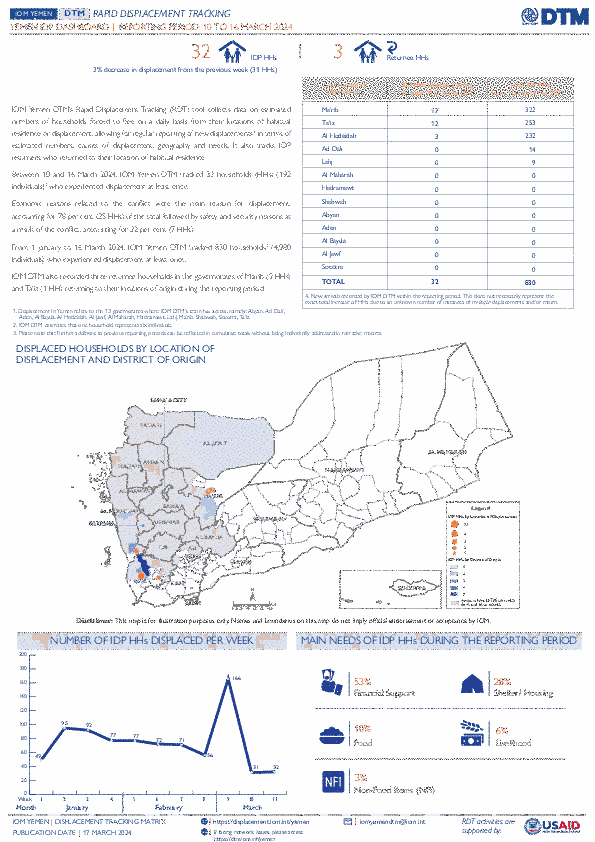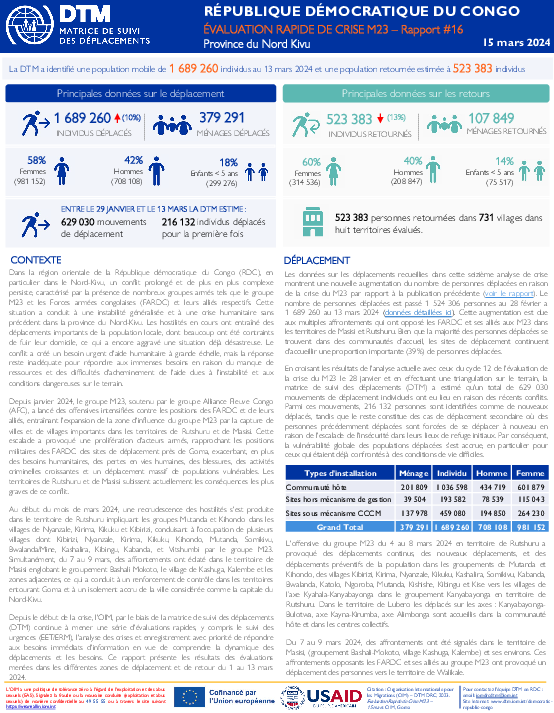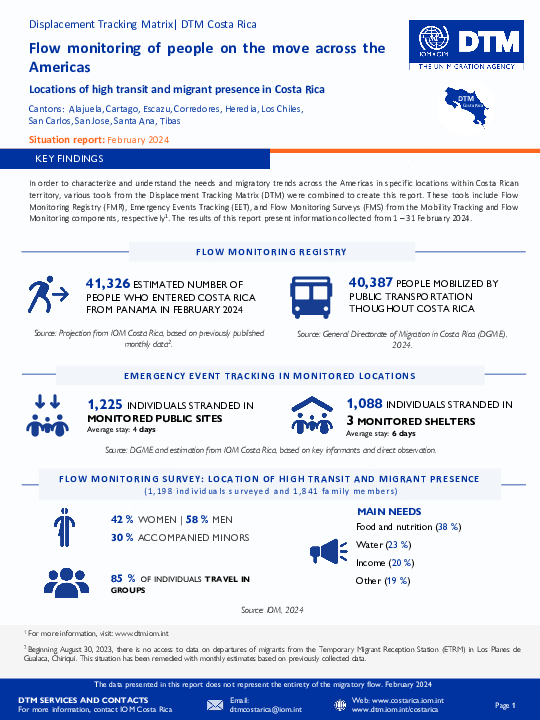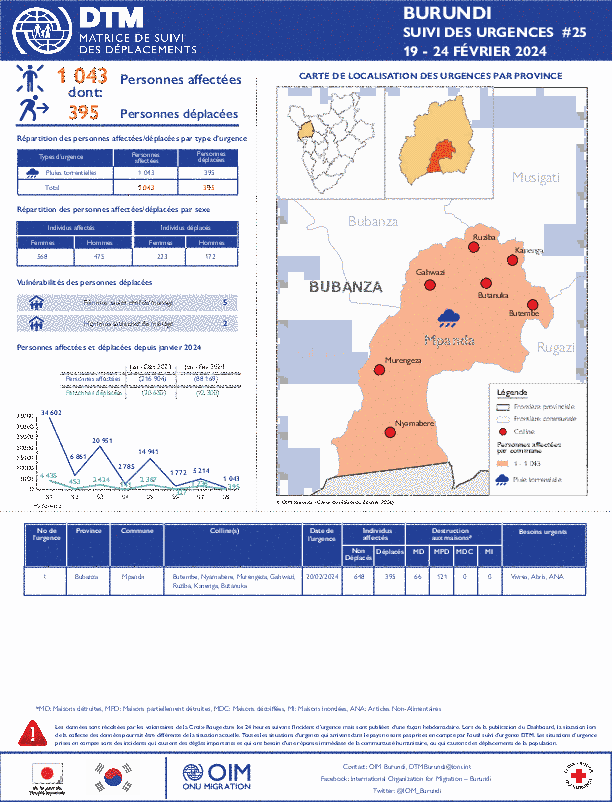-
Countries
-
Data and Analysis
-
Special Focus
-
Crisis Responses
Event Tracking
Contact
DTM Yemen, iomyemendtm@iom.int
Location
Yemen
Activity
- Mobility Tracking
- Event Tracking
Period Covered
Mar 10 2024 -Mar 16 2024
From 1 January to 16 March 2024, IOM Yemen DTM tracked 830 households (HH) (4,980 Individuals) who experienced displacement at least once.
Between 10 and 16 March 2024, IOM Yemen DTM tracked 32 households (192 individuals) displaced at least once. The majority of people moved into/within the following governorates and districts:
- Ma’rib (17 HHs) – Ma’rib City (9 HHs), Ma’rib (8 HHs) districts. Most displacements in the governorate originated from Ma’rib and Al Hodeidah.
- Ta’iz (12 HHs) – Mawza (11 HH), Al Mawasit (1 HH) districts. Most displacements in the governorate were internal.
- Al Hodeidah (3 HHs) – Hays (3 HHs) district. All displacements in the governorate were internal.
- Ta’iz (12 HHs) – Maqbanah (7 HHs), Mawza (3 HHs), Mashrah Wa Hadnan (1 HH) districts.
- Al Hodeidah (7 HHs) – Al Jarrahi (3 HHs), Al Marawiah (2 HHs), Al Hawak (1 HH) districts.
- Ma’rib (4 HHs) – Al Jubah (2 HHs), Harib (2 HHs) districts.
Population Groups
Survey Methodology
Unit of Analysis Or Observation
Type of Survey or Assessment
Keywords
Geographical Scope
Administrative boundaries with available data
The current dataset covers the following administrative boundaries

Contact
DTM Yemen, iomyemendtm@iom.int
Language
English
Location
Yemen
Period Covered
Mar 10 2024
Mar 16 2024
Activity
- Mobility Tracking
- Event Tracking
IOM Yemen DTM’s Rapid Displacement Tracking (RDT) tool collects data on estimated numbers of households forced to flee on a daily basis from their locations of origin or displacement, allowing for regular reporting of new displacements in terms of estimated numbers, geography, and needs. It also tracks returnees who returned to their location of origin.
From 1 January to 16 March 2024, IOM Yemen DTM tracked 830 households (HH) (4,980 Individuals) who experienced displacement at least once.
Between 10 and 16 March 2024, IOM Yemen DTM tracked 32 households (192 individuals) displaced at least once. The majority of people moved into/within the following governorates and districts:
- Ma’rib (17 HHs) – Ma’rib City (9 HHs), Ma’rib (8 HHs) districts. Most displacements in the governorate originated from Ma’rib and Al Hodeidah.
- Ta’iz (12 HHs) – Mawza (11 HH), Al Mawasit (1 HH) districts. Most displacements in the governorate were internal.
- Al Hodeidah (3 HHs) – Hays (3 HHs) district. All displacements in the governorate were internal.
The majority of people moved from the following governorates and districts:
- Ta’iz (12 HHs) – Maqbanah (7 HHs), Mawza (3 HHs), Mashrah Wa Hadnan (1 HH) districts.
- Al Hodeidah (7 HHs) – Al Jarrahi (3 HHs), Al Marawiah (2 HHs), Al Hawak (1 HH) districts.
- Ma’rib (4 HHs) – Al Jubah (2 HHs), Harib (2 HHs) districts.
IOM identified 16 households displaced in the previous reporting period, which covered 03 - 09 March 2024, in the governorates of Al Hodeidah (11 HH), Ma’rib (4 HHs), and Ta’iz (1 HH). These figures have been added to the cumulative displacement total recorded since the beginning of the year.

Contact
DTMMozambique@iom.int
Language
English
Location
Mozambique
Period Covered
Mar 15 2024
Mar 15 2024
Activity
- Mobility Tracking
- Event Tracking
Mozambique’s National Institute for Disaster Management (INGD) estimates more than 525,000 people to be affected by the landfall of Tropical Storm Filipo directly impacting communities of Inhambane, Gaza, Sofala and Maputo from 14 March. As of 14 March 2024, available reports indicate 208 individuals (54 families) still present in 2 accommodation centres (ACs) in Inhambane. Escola 3 de Fevereiro de Malaia and Centro de transito de Machocomane schools in Morrumbele and Vilankulo respectively have been deactivated following the return of families to places of usual residence. Shelter and non-food items have been reported as the top most priority needs among all accommodation centres. Other reported priority needs include Agriculture and Food security, healthcare and access to markets. Preliminary updates from ongoing joint assessments estimates 48,122 individuals (8,490 families) affected in 30 locations across Inhambane, Gaza, Sofala and Maputo provinces. As rain and flood events develop, ongoing joint assessments with INGD and humanitarian partners monitor the needs and conditions of affected populations in the region.

Contact
DTM DRC, iomdrcdtm@iom.int
Language
French
Location
Democratic Republic of the Congo
Period Covered
Mar 01 2024
Mar 13 2024
Activity
- Mobility Tracking
- Event Tracking
Dans la région orientale de la République démocratique du Congo (RDC), en particulier dans le Nord-Kivu, un conflit prolongé et de plus en plus complexe persiste, caractérisé par la présence de nombreux groupes armés tels que le groupe M23 et les Forces armées congolaises (FARDC) et leurs alliés respectifs. Cette situation a conduit à une instabilité généralisée et à une crise humanitaire sans précédent dans la province du Nord-Kivu. Les hostilités en cours ont entraîné des déplacements importants de la population locale, dont beaucoup ont été contraints de fuir leur domicile, ce qui a encore aggravé une situation déjà désastreuse. Le conflit a créé un besoin urgent d'aide humanitaire à grande échelle, mais la réponse reste inadéquate pour répondre aux immenses besoins en raison du manque de ressources et des difficultés d'acheminement de l'aide dues à l'instabilité et aux conditions dangereuses sur le terrain.
Depuis janvier 2024, le groupe M23, soutenu par le groupe Alliance Fleuve Congo (AFC), a lancé des offensives intensifiées contre les positions des FARDC et de leurs alliés, entraînant l'expansion de la zone d'influence du groupe M23 par la capture de villes et de villages importants dans les territoires de Rutshuru et de Masisi. Cette escalade a provoqué une prolifération d'acteurs armés, rapprochant les positions militaires des FARDC des sites de déplacement près de Goma, exacerbant, en plus des besoins humanitaires, des pertes en vies humaines, des blessures, des activités criminelles croissantes et un déplacement massif de populations vulnérables. Les territoires de Rutshuru et de Masisi subissent actuellement les conséquences les plus graves de ce conflit.
Au début du mois de mars 2024, une recrudescence des hostilités s'est produite dans le territoire de Rutshuru impliquant les groupes Mutanda et Kihondo dans les villages de Nyanzale, Kirima, Kikuku et Kibirizi, conduisant à l'occupation de plusieurs villages dont Kibirizi, Nyanzale, Kirima, Kikuku, Kihondo, Mutanda, Somikivu, Bwalanda/Mine, Kashalira, Kibingu, Kabanda, et Vitshumbi par le groupe M23. Simultanément, du 7 au 9 mars, des affrontements ont éclaté dans le territoire de Masisi englobant le groupement Bashali Mokoto, le village de Kashuga, Kalembe et les zones adjacentes, ce qui a conduit à un renforcement de contrôle dans les territoires entourant Goma et à un isolement accru de la ville considérée comme la capitale du Nord-Kivu.
Depuis le début de la crise, l'OIM, par le biais de la matrice de suivi des déplacements (DTM) continue à mener une série d'évaluations rapides, y compris le suivi des urgences (EET/ERM), l'analyse des crises et enregistrement avec priorité de répondre aux besoins immédiats d'information en vue de comprendre la dynamique des déplacements et les besoins.
Ce rapport présente les résultats des évaluations menées dans les différentes zones de déplacement et de retour du 1 au 13 mars 2024.

Contact
DTM DRC, iomdrcdtm@iom.int
Language
English
Location
Democratic Republic of the Congo
Period Covered
Mar 01 2024
Mar 13 2024
Activity
- Mobility Tracking
- Event Tracking
In the eastern region of the Democratic Republic of Congo (DRC), particularly in North Kivu, a prolonged and increasingly complex conflict persists, characterized by the presence of numerous armed actors such as the M23 group and the Congolese Armed Forces (FARDC) and their respective allies. This situation has led to widespread instability and an unprecedented humanitarian crisis in North Kivu province. The ongoing hostilities have led to significant displacement of the local population, many of whom have been forced to flee their homes, further exacerbating an already dire situation. The conflict has created an urgent need for large-scale humanitarian aid, but the response remains inadequate to meet the immense needs due to a lack of resources and difficulties in delivering aid due to instability and dangerous conditions on the ground.
Since January 2024, the M23 group, supported by the Alliance Fleuve Congo (AFC) group, has launched intensified attacks against positions belonging to the FARDC and their allies, resulting in the expansion of the M23 group's zone of influence through the capture of major towns and villages in the Rutshuru and Masisi territories. This escalation has led to a proliferation of armed individuals, bringing FARDC military positions closer to displacement sites near Goma, exacerbating, in addition to humanitarian needs, loss of life, injuries, growing criminal activity and massive displacement of vulnerable populations. The territories of Rutshuru and Masisi are currently suffering the most serious consequences of this conflict.
In early March 2024, renewed hostilities broke out in Rutshuru territory involving the Mutanda and Kihondo groups in the villages of Nyanzale, Kirima, Kikuku and Kibirizi, leading to the occupation of several villages including Kibirizi, Nyanzale, Kirima, Kikuku, Kihondo, Mutanda, Somikivu, Bwalanda/Mine, Kashalira, Kibingu, Kabanda, and Vitshumbi by the M23 armed group. Simultaneously, from March 7 to 9, clashes broke out in Masisi territory encompassing the Bashali Mokoto groupement, the village of Kashuga, Kalembe and adjacent areas, leading to a reinforcement of control in the territories surrounding Goma and further isolation of the city considered the capital of North Kivu.
Since the onset of the crisis, IOM, through the Displacement Tracking Matrix (DTM) continues to conduct a series of rapid assessments, including Emergency Tracking (EET/ERM), Crisis Analysis and Registration with priority to address immediate information needs with a view to understanding displacement dynamics and needs.
This report presents the results of assessments carried out in the various displacement and return areas from March 1 to 13, 2024.

Contact
DTMCostaRica@iom.int
Language
English
Location
Costa Rica
Period Covered
Feb 01 2024
Feb 29 2024
Activity
- Flow Monitoring
- Mobility Tracking
- Event Tracking
Cantons: Alajuela, Cartago, Escazú, Corredores, Heredia, Los Chiles, San Carlos, San José, Santa Ana, Tibás
Costa Rica, like the other countries in the Central American region, has been characterized as a migratory corridor for people who transit by land from the south to the north of America and whose destination is the countries in the north of the continent. This flow on the move through the Americas is mainly made up of people from the Bolivarian Republic of Venezuela, Cuba, Haiti, Ecuador, as well as people from other countries in South America, Africa and Asia.
According to estimations from IOM Costa Rica, during February 41,326 people entered the country, an approximate average of 1,425 people per day and estimating a increase of 10% compared to January 2024. In addition, 1,088 people stranded in the monitored shelters were identified and 1,225 people stranded in the public places visited.
Contact
dtmuganda@iom.int
Location
Uganda
Activity
- Event Tracking
Period Covered
Jan 06 2024 -Feb 01 2024
In January, the impacts of the hazards affected 1,654 individuals (288 households), with 685 people from 125 households were internally displaced.
A more detailed version of this dataset is available, to get access kindly click on the 'Request Access' button
Population Groups
IDPs
Residents
Survey Methodology
Unit of Analysis Or Observation
Admin Area 2
Admin Area 3
Admin Area 4
Community
Type of Survey or Assessment
Key Informant
Keywords
Geographical Scope Full Coverage
Administrative boundaries with available data
The current dataset covers the following administrative boundaries
Contact
dtmuganda@iom.int
Location
Uganda
Activity
- Event Tracking
Period Covered
Feb 01 2024 -Feb 29 2024
In February 2024, the impacts of the hazards affected 3,935 individuals (993 households), with 1,525 people from 271 households were internally displaced.
A more detailed version of this dataset is available, to get access kindly click on the 'Request Access' button
Population Groups
IDPs
Residents
Survey Methodology
Unit of Analysis Or Observation
Admin Area 2
Admin Area 3
Community
Type of Survey or Assessment
Key Informant
Keywords
Geographical Scope Full Coverage
Administrative boundaries with available data
The current dataset covers the following administrative boundaries

Contact
DTMMozambique@iom.int
Language
English
Location
Mozambique
Period Covered
Mar 13 2024
Mar 13 2024
Activity
- Mobility Tracking
- Event Tracking
Mozambique’s National Institute for Disaster Management (INGD) estimates more than 525,000 people to be affected by the landfall of Tropical Storm Filipo directly impacting communities of Inhambane, Sofala and Maputo from 12 March. As of 11 March, INGD have estimated more than 55,000 people already affected since the 2023/2024 rainy season started. As of 13 March 2024, available reports indicate 1,388 individuals (218 families) have taken shelter in 4 accommodation centres (ACs) in Inhambane. 1,038 (148 families) are accommodated in 3 schools whilst 350 individuals (70 families) are accommodated at a local church in Malaia locality. Shelter and non-food items have been reported as the top most priority needs among all accommodation centres. Other reported priority needs include Agriculture and Food security, WASH, health and access to markets. As rain and flood events develop, ongoing joint assessments with INGD and humanitarian partners monitor the needs and conditions of affected populations in the region.
Pagination
- Previous page
- Page 39
- Next page

